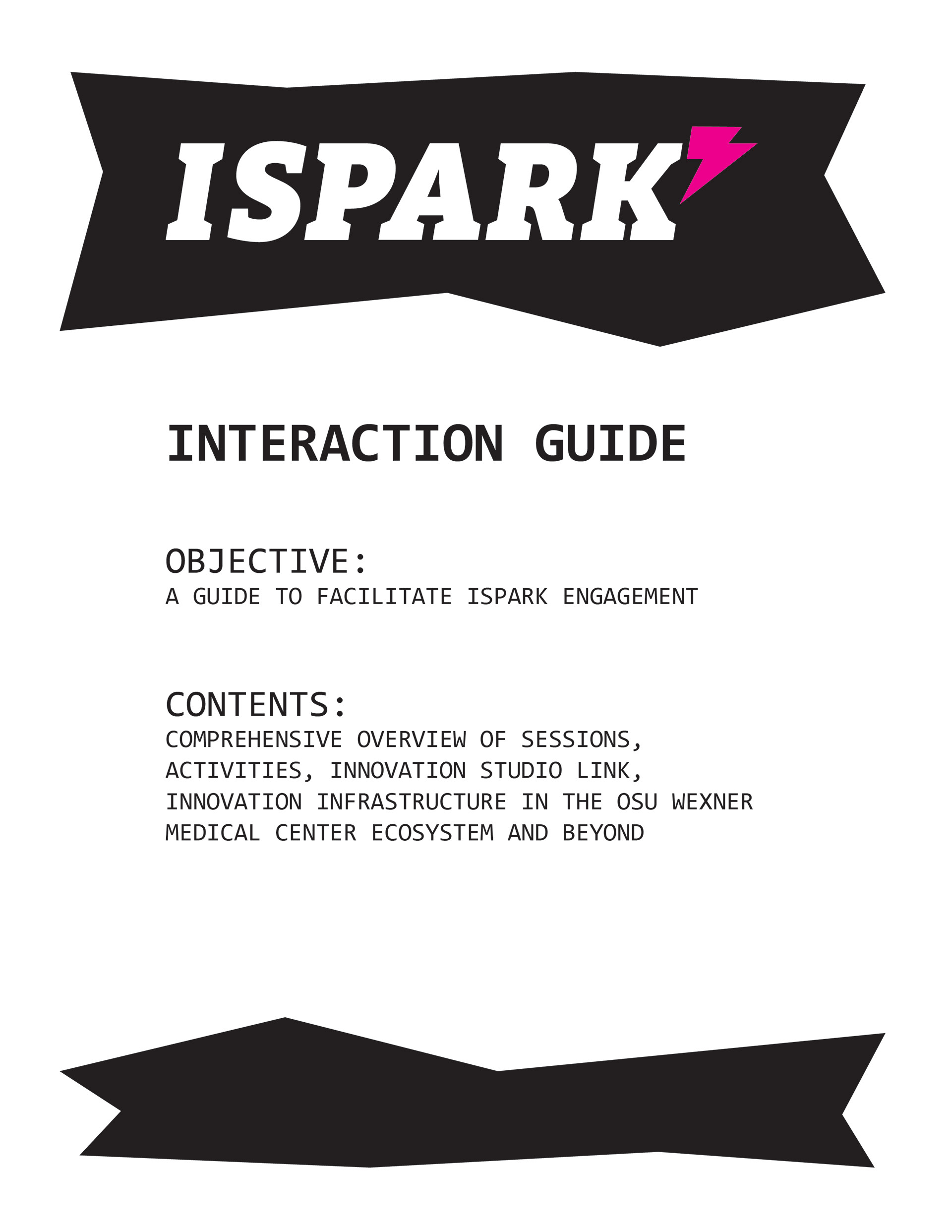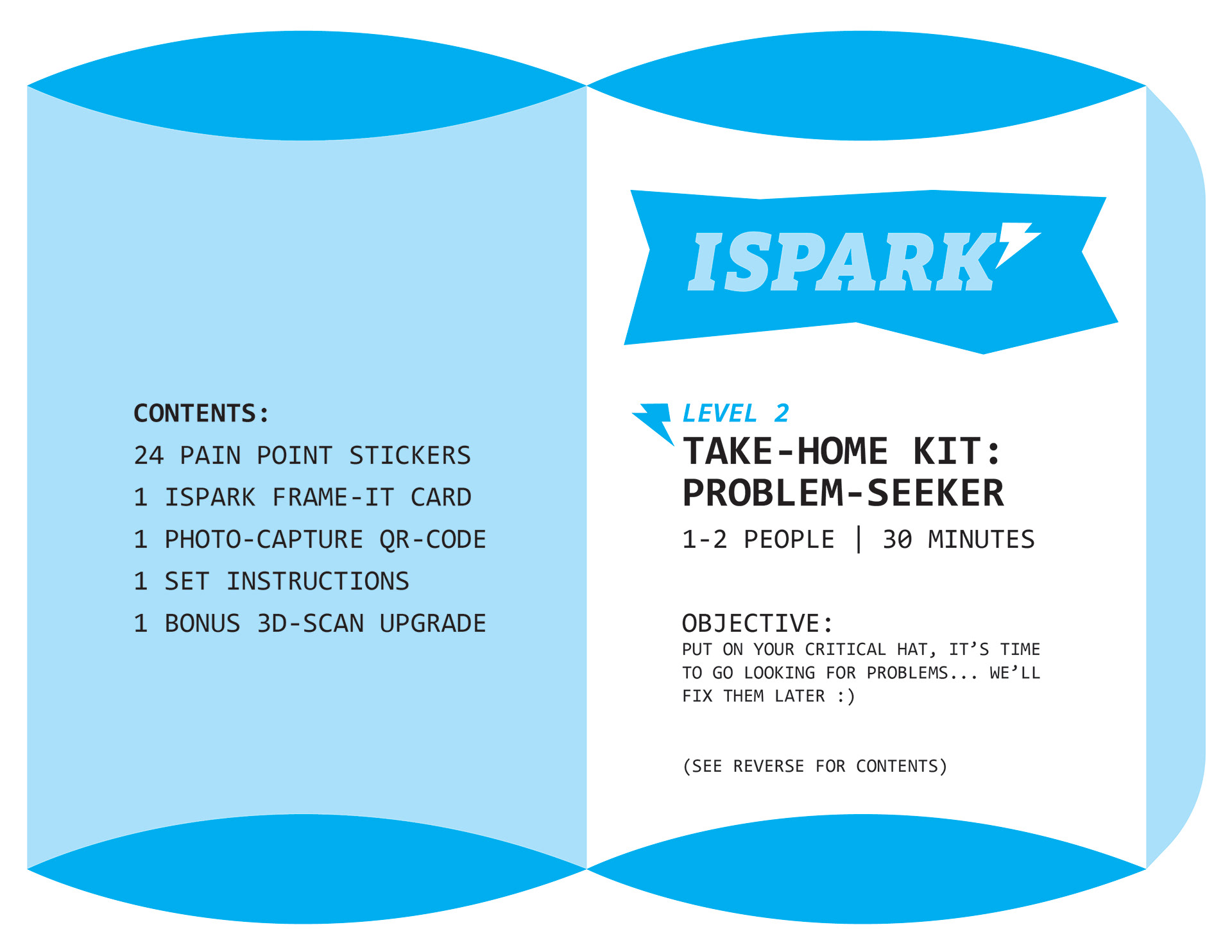ISPARK Mobile Maker Cart
4 Weeks | Small Interdisciplinary Team | Healthcare Innovation | Design & Build
The folks at Innovation Studio, a multi-location maker-space managed by the College of Nursing at Ohio State, had a radical question: how might we close the gap between healthcare innovation and the bedside. They also had a starting point: $5,000 to build a mobile maker-space "cart" to bring maker "stuff" onto two different Intensive Care Units (ICUs) in the Wexner Medical Center (WMC).
One question they had was, maybe we could load up a "crash cart," (like the one pictured below) with a 3D printer, then bring it to an ICU to get nurses and doctors inventing?
There were plenty of unanswered questions... several of which my small team quickly uncovered: What should be on the cart? How would the cart facilitate engagement with innovation? What can a cart do on its own? What can't a cart do on its own? Who might be involved with the cart, intentionally or otherwise? How might the cart play a role in connecting folks in ICUs with the broader innovation infrastructure at Ohio State and beyond?






ISPARK team (above):
Lead Designer – William Nickley, Assistant Professor, Design, Ohio State
Lead Fabricator – Zachary Sanderson, Manager, Innovation Studio
Project Lead – Susan O'Hara, Assistant Clinical Professor, Nursing, Ohio State
Designer & Fabricator – Catalina Munoz-Arias, MFA Candidate, Design, Ohio State
Designer – Heloisa Rocha Rincon, MFA Candidate, Design, Ohio State
Michael Ackerman, Clinical Professor, Masters of Healthcare Innovation, Ohio State

One of the design team's first steps was to perform a cart audit (above). We gathered nearly 50 examples of inspirational carts and cart-like organization objects from nursing, healthcare, education, craft-making, tool organization, and home decor. Then, we documented and categorized features, attributes and uses.
Next, we conducted co-design sessions with nurse leaders from Wexner Medical Center (WMC) (like the one pictured above) to gather information about the past and present innovation climate in and around WMC ICUs, then allow our co-design participants to envision the future of innovation (with or without carts!). A portion of the co-design activities challenged participants to envision potential users of the yet-to-be-envisioned ISPARK cart, further detailing their motivations and modes of engagement.
Fun fact: we were surprised by the difference between how we (designers), innovation studio folks, nurse leaders and nurses thought about "innovation." For example, many nurses make "work-arounds," or small modifications to equipment, procedure, policy for the benefit of their patients and/or colleagues. However, nurses don't see work-arounds as "innovations," while the design team does!
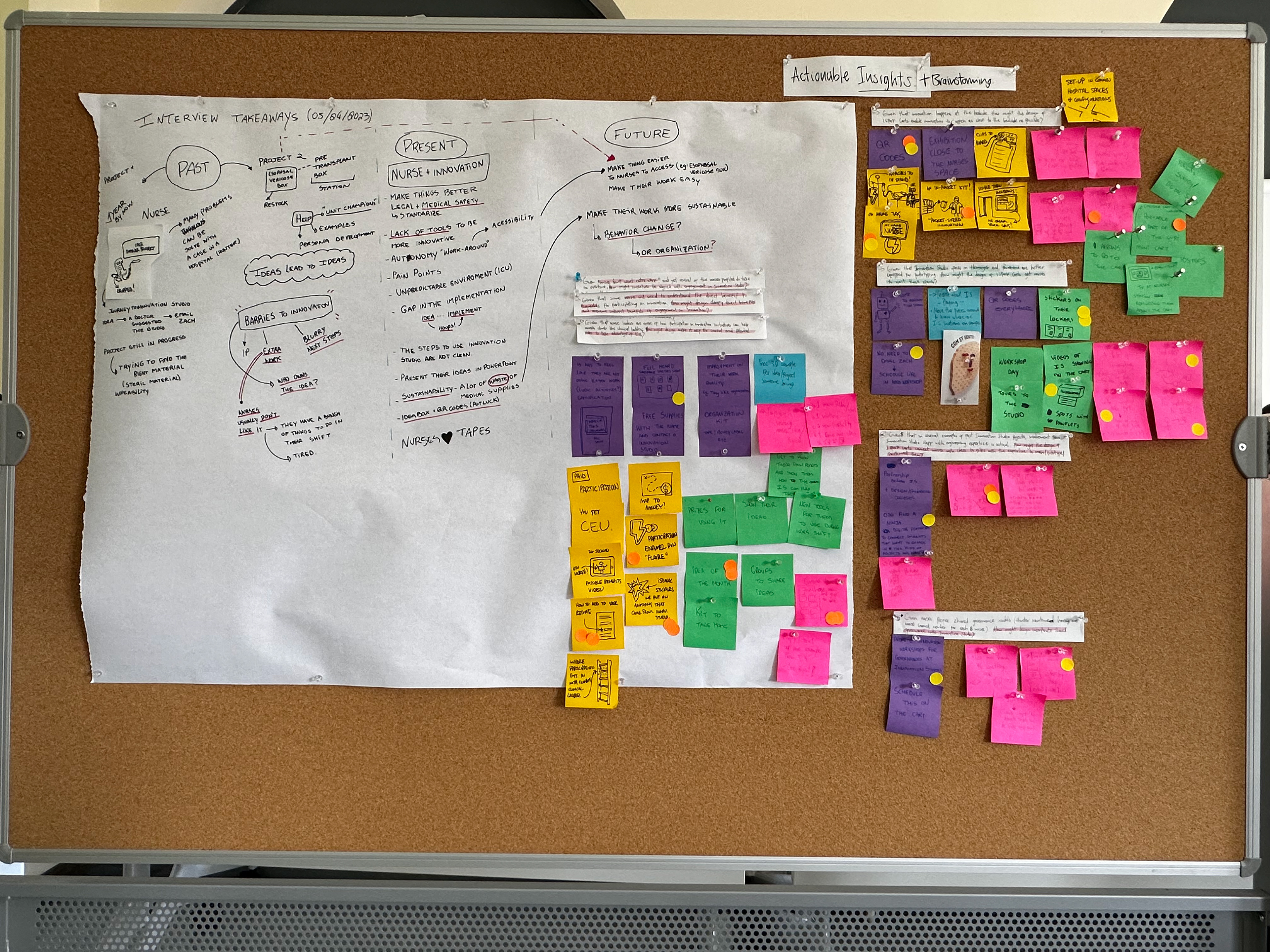

The entire ISPARK team toured two WMC ICU facilities with nurse leaders, gathering observations and having conversations with folks on the units. Data gathered from our tours and co-design sessions with WMC nurse leaders seeded a brainstorming session focused on fostering innovation at the bedside, resulting in 160+ ideas about the form, content. Then, our design team sorted and consolidated ideas into 18 Actionable Insights (pictured above) for Innovation Studio to potentially enact through the development of their ISPARK cart concept. Notably, the design team envisioned a robust engagement framework including several tiered activities that potential users would encounter at, near, around, because of and in spite of the cart!
Critical to conveying the potential behind identified insights was composing an overarching innovation model for the ISPARK cart (above), situated within the existing innovation infrastructure at WMC and Ohio State as well as embedded within WMC's healthcare infrastructure.
Fun fact: A frequently asked question that had emerged in several meetings, research settings, and informal discussions about the project was, "where will the cart go?" During one of our tours of an ICU, we were probing for where informal interpersonal activity happens on the unit. Our nurse tour guide responded it all happens "where the cake goes" (i.e., where people typically place a birthday cake they bring for a colleague). Our cart needs to go where the cake goes, because that's where the types of innovation conversations Innovation Studio wants to leverage already happen.
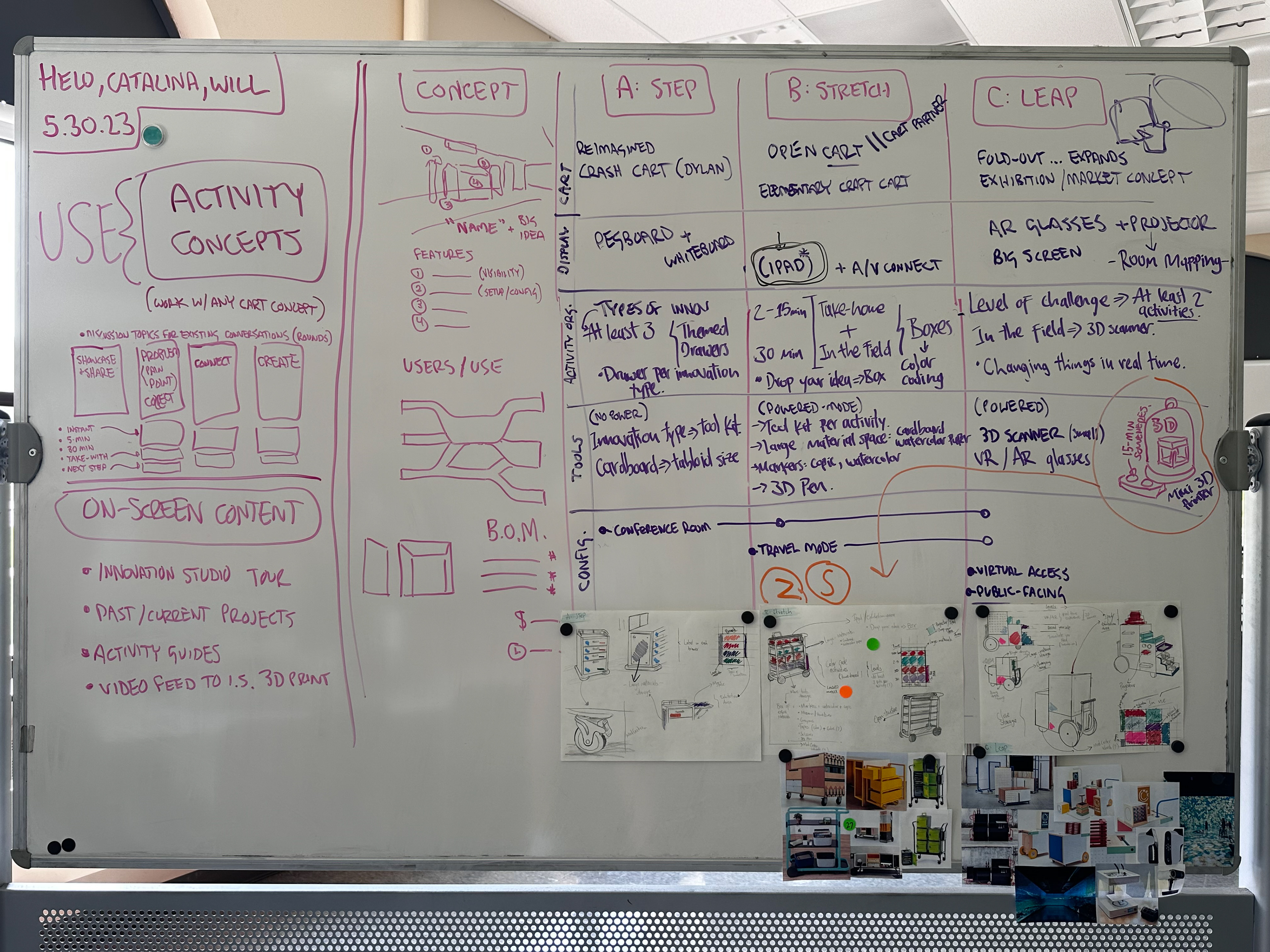

Actionable insights were integrated into the overarching vision for ISPARK Cart's role in connecting innovation infrastructure and the bedside, transformed into "step," "stretch," and "leap," concepts. Each would facilitate a baseline of activities and engagements; cart architecture, display, activity organization, tools, and configurations differentiated the concepts. When presented to Innovation Studio folks, the Stretch concept was selected for its blend of innovation and viability.





Design team members carried the feature set of our Stretch concept into a refinement phase focused on packaging everything into a unique cart architecture (above).


Additional refinement combined the best (feasible, usable) features into a single concept with an "approachable quirkiness" (above) befitting innovation in the often sterile ICU environment. Design requirements included needing to be able to manufacture the cart using Innovation Studio equipment!
The final ISPARK cart architecture (above) comprised flat plywood panels, standard cabinet hardware, and a few 3D-printed parts for cord management.
Our final design concept presentation highlighted features of an ISPARK Mobile Maker Cart that is Discoverable, Flexible, and Secure (above, below).
Access living Spec Packet online here: https://go.osu.edu/ispark-spec-packet
Access living Bill of Materials here: https://go.osu.edu/ispark-bom
Access CNC layout files here: https://go.osu.edu/ispark-cnc
Access 3D printable files here: https://go.osu.edu/ispark-3dprint
Access related design presentation here: https://go.osu.edu/ispark-design-presentation






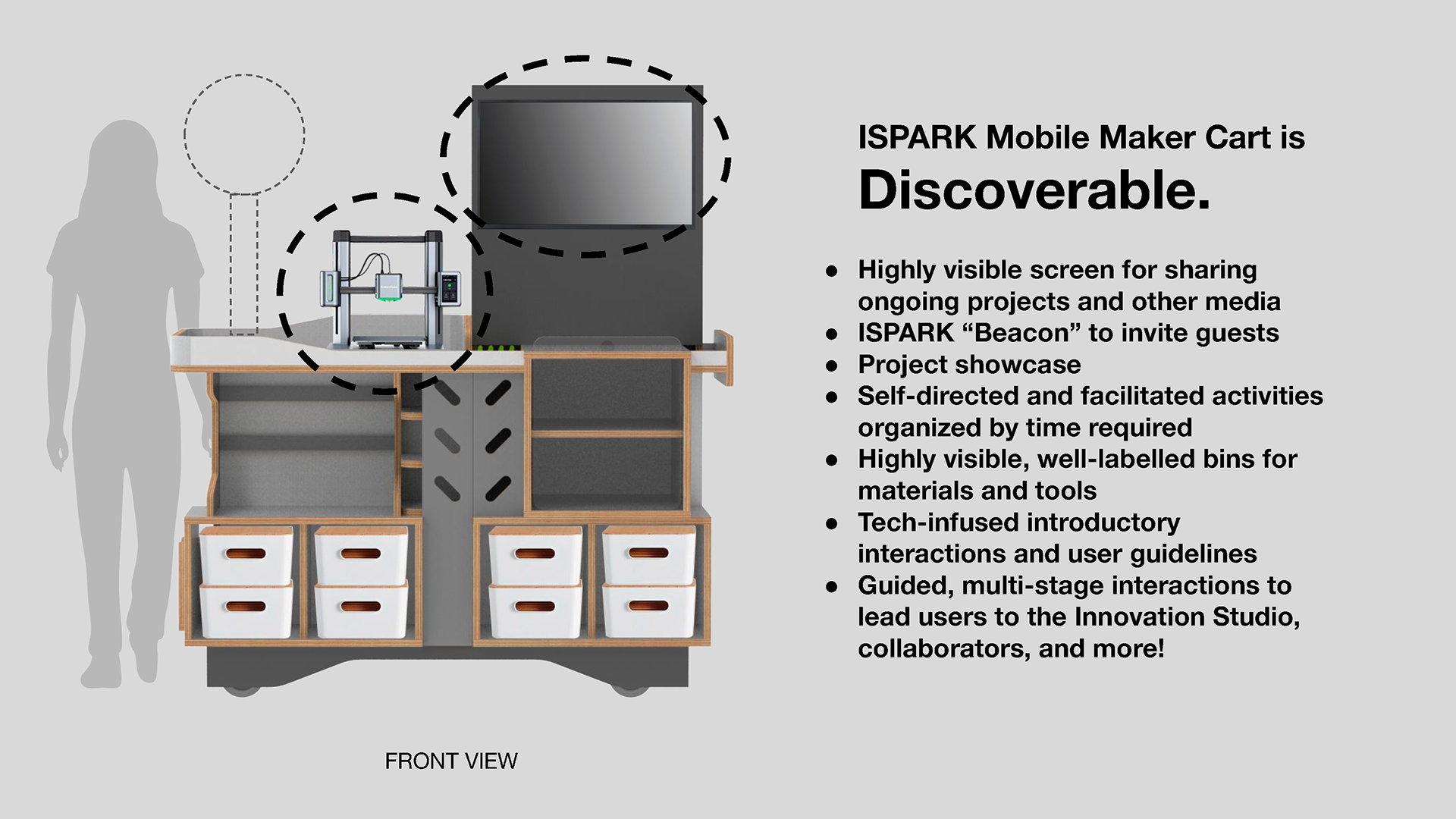




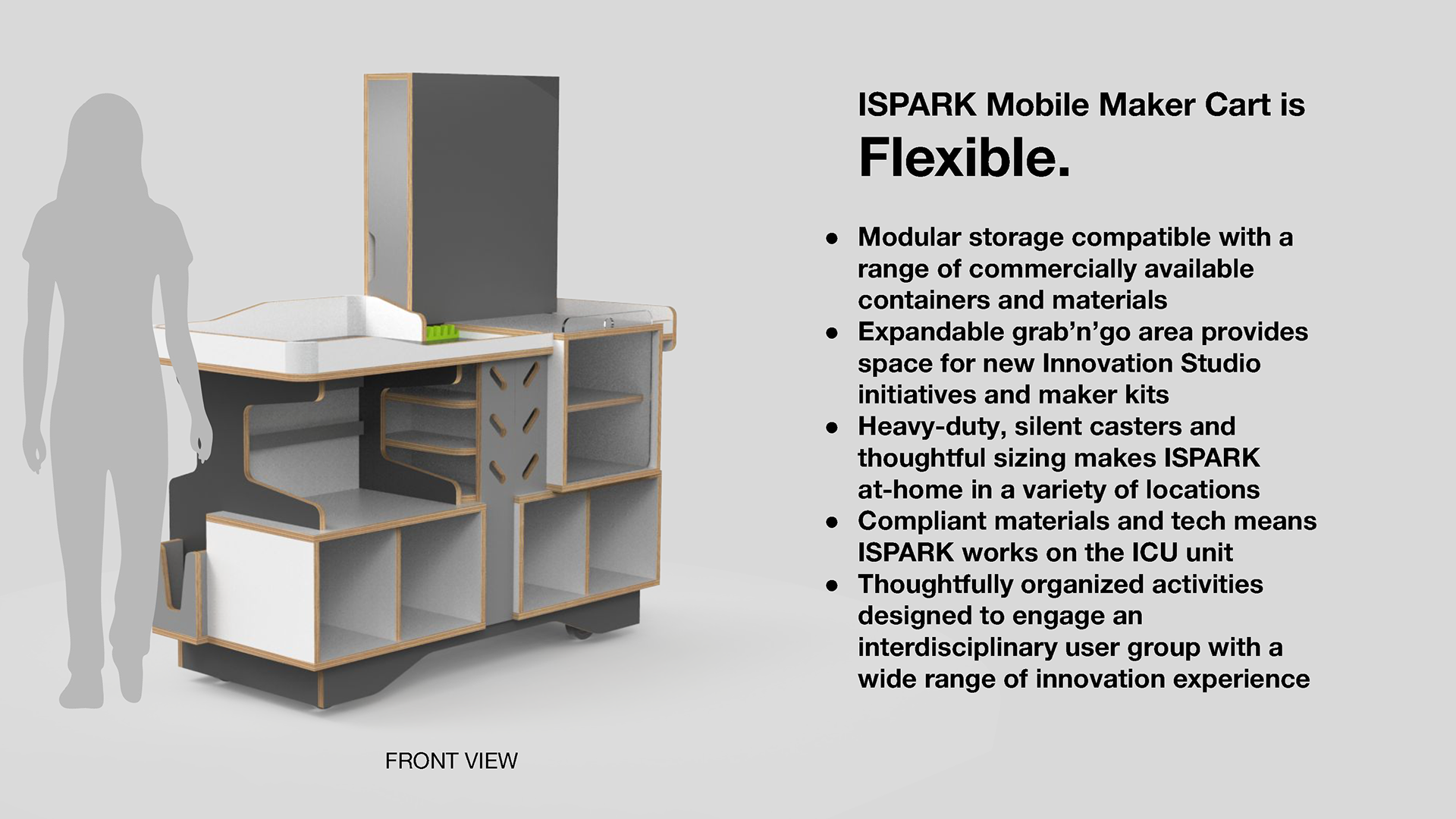







Accompanying the design concept presentation were a 3D model, technical drawings, and a specifications packet complete with bill of materials (above).
ISPARK Cart was carefully crafted for single-person maneuverability around the ICU environment and to be visually distinct from existing carts (above).


Proposed construction materials included high-pressure laminate (HPL) covered plywood and 3D-printed components, affording a wide array of color options (above). Guidelines for color application emphasize varying functions of each distinct area of the ISPARK cart.




During Summer, 2023, with help from a fabrication specialist from the Studios for Arts & Design Research (SADR) at Ohio State (thanks, Paul Tenwalde!), the design team fabricated the first, full-scale and fully operational ISPARK Mobile Maker Cart (above). During the fabrication process, we also started a cart build guide with the hope of building a second cart and releasing plans for others to use.
We unveiled the completed ISPARK Mobile Maker Cart in late 2023 on-location at Innovation Studio's main on-campus location, decked-out in maker equipment, placeholder branding and activities (above, below).





During the first half of 2024, the cart lived in Innovation Studio's Heminger Hall location, pictured below with newly sealed edges and "making" supplies. Wexner Medical Center has an official launch planned for Autumn, 2024, after which two ISPARK carts will be on-unit with two different ICUs. The College of Nursing at Ohio State also published a nice write-up about the project's origins here.
Next steps
In the view of the design team, the physical ISPARK cart is only half of the design solution; the other half comprises activities, services, and policy surrounding the cart's use within the broader innovation and healthcare infrastructures at WMC and Ohio State. Graphics (below) comprise prototype activities that needing further development before implementation.
